Yesterday’s liveblog can be found here. An archive of our liveblogs can be found here. For an overview and analysis of this developing story see our latest podcast.
Please help The Interpreter to continue providing this valuable information service by making a donation towards our costs.
View Ukraine: April, 2014 in a larger map
For links to individual updates click on the timestamps.
For the latest summary of evidence surrounding the shooting down of flight MH17 see our separate article: Evidence Review: Who Shot Down MH17?
Below we will be making regular updates so check back often.
Yesterday, October 8, we reported that shells that struck apartment buildings in Donetsk on October 7 most likely did not come from the Ukrainian army positions to the north at the Donetsk Airport, but likely came from the northeast, perhaps from a firing position the Russian-backed separatists have established outside of Donetsk near a slag heap.
Now we have found another incident involving the shelling of a
supermarket yesterday in which at least 9 people were injured and apparently 2 were killed, buildings
were damaged, and merchandise destroyed.
Russian state media and separatist news rushed to blame the
shelling once again on Ukrainian forces, and indeed the Ukrainian army is
responsible at times for indiscriminate shelling as they return fire
provoked by separatists. This graphic footage
with close shots of damage inside the store from the state-run Ruptly
and this interview with a store manager made by the Russian
ultranationalist group Essence of Time, with interior shots, are
typical:
But in this case, as in others, such as the attack on the bus and
school that killed 9 people, the separatists appear to be to blame.
From both tweets and Russian state media accounts, we know that the
address of the store is 38 Sokolnaya Street, which is located here on Google Maps and here on Google Street View.
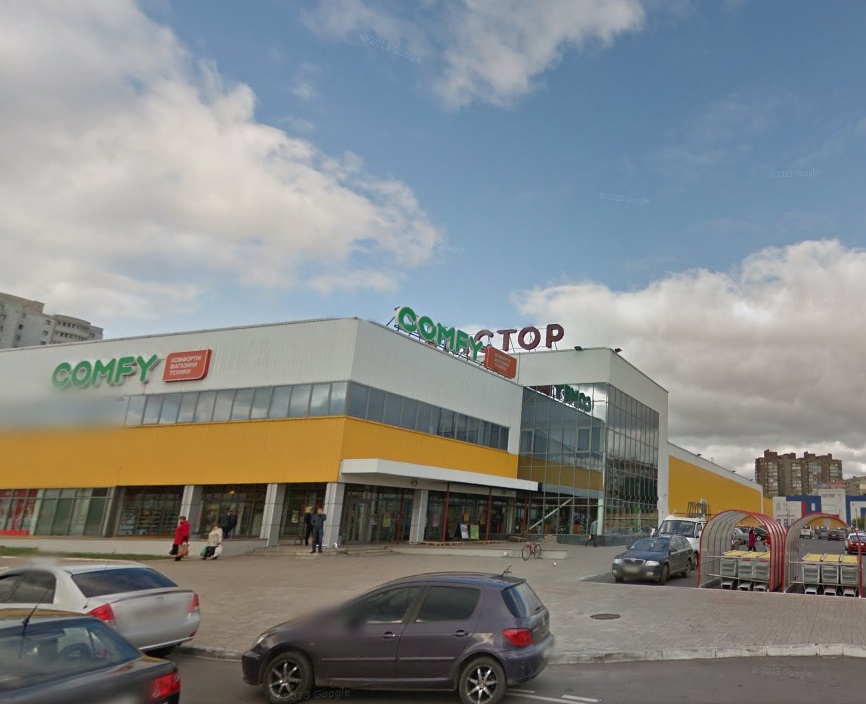
This video uploaded by a citizen reporter to YouTube
and titled “Amstor, Sportsmax in Kuybyshev District Donetsk 8 10 2014”
is taken from the perspective of a high-rise apartment building over the
Amstor, where the Comfy store is also located.
First the cameraman shows his own apartment which has had its windows broken. He then pans the camera out this window on to the roof of the Amstor
below and we can see the letters of the Comfy store on the roof:
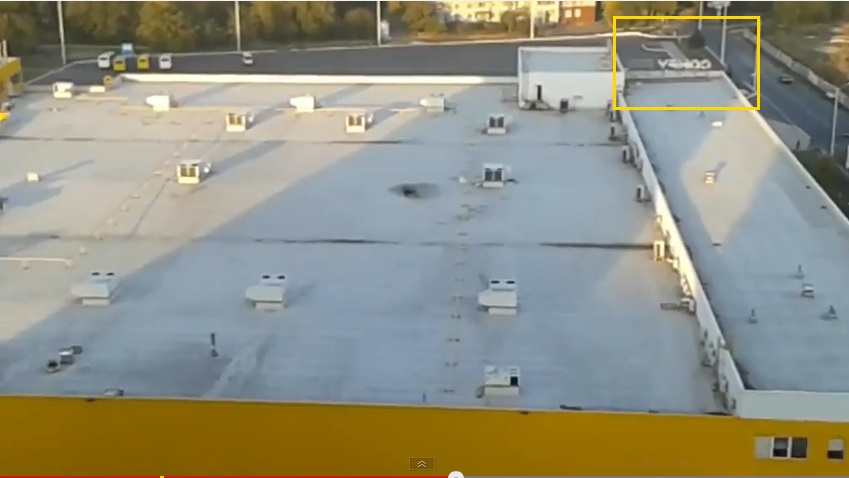
Looking at Google Street View we can see the cameraman’s position
looking southwest down Sokolnaya Street toward the apartment buildings
which are perpendicular on Kuybyshev Street. As you can see, there is another rocket impact on the top of the store, but as we’re about to see, there is another rocket impact, marked by another red square. The window faces east.
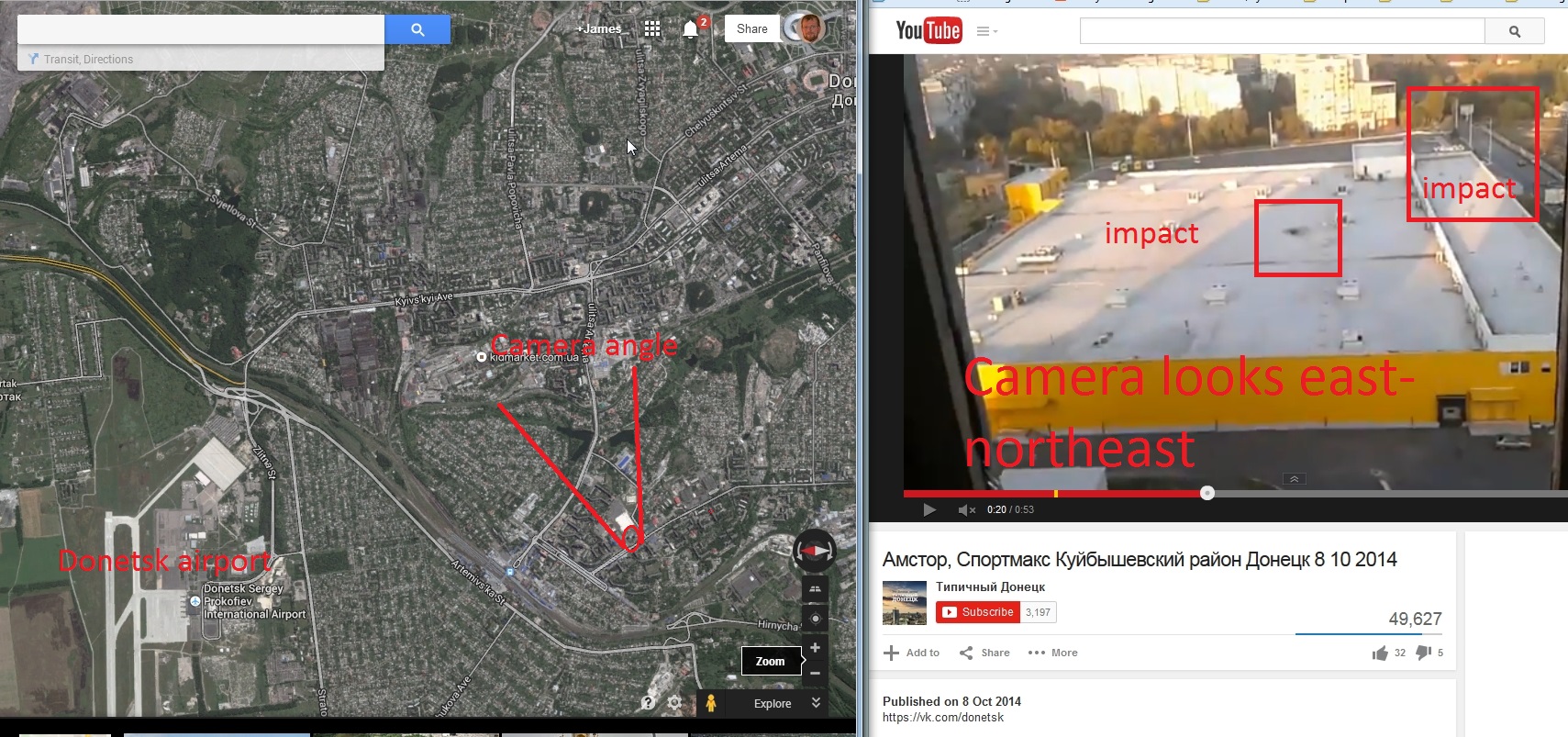
There have been a lot of attempts to trace the angle of the hole in the roof of the store. Some have theorized that the shot came from the northeast (away from the camera and to the left) while others have suggested that the hole looks like it came from the southeast (away from the camera and to the right). Others have suggested that it came from the northwest, from Donetsk airport. We’re not convinced that any of the arguments are definitive without a closer view of the hole in the roof. Here’s a closeup of the hole:
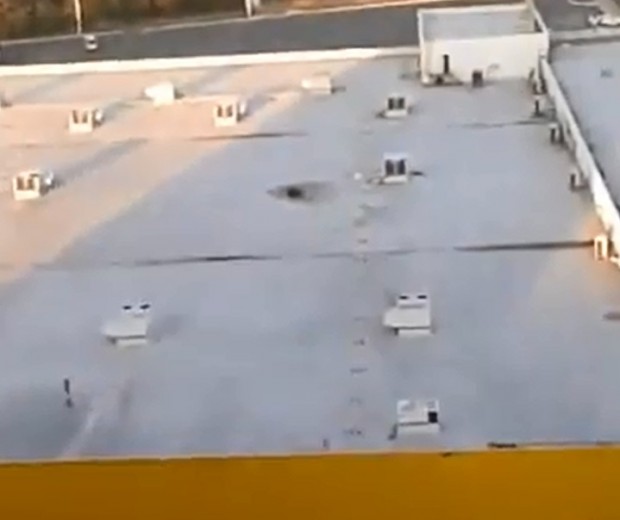
We can see from the Ruptly video (warning: graphic) at 0:0, what the hole looks like from inside the store:
In the video there is the remnant of a piece of metal which could be part of a rocket. It’s possible that a series of rockets or shells caused all of this damage, as multiple impacts are reported in the same area at the same time, and we have found evidence of at least three impacts. This fits the pattern of what might happen when Grad rockets hit an area, for example.
Remember that second impact which we noted above? Here’s a tweet from a Donetsk resident showing the same scene in front
of the Amstor looking southwest toward the shelled apartment buildings.
She is examining a crater in the road – the camera is facing approximately southwest:
Translation: The shell that fell on the Amstor flew from the side of the DPR [“Donetsk People’s Republic”]
This picture shows the impact crater, which we have tried to map to the best of our ability:
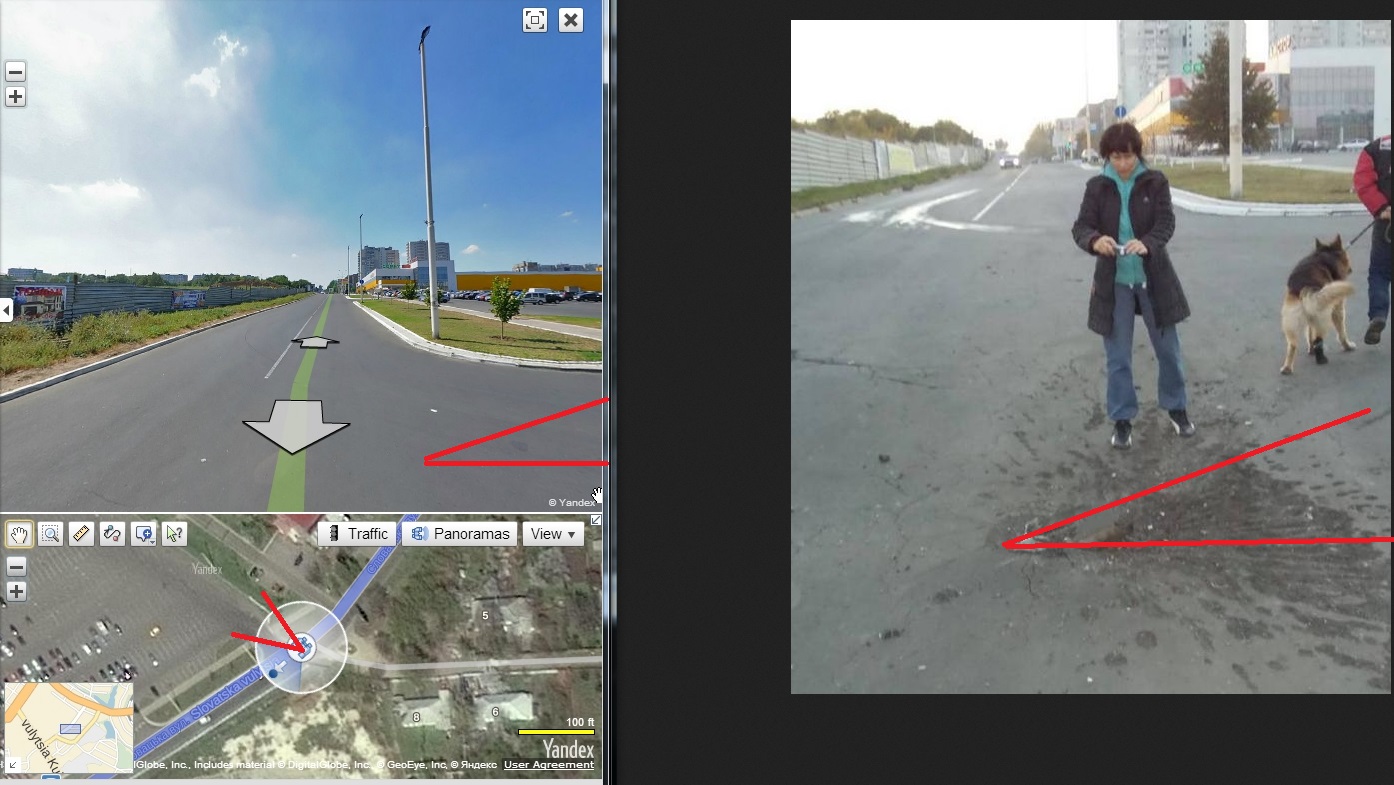
Here is what this looks like if you extrapolate those angles to a larger map. As you can see, this suggests that the rocket may have actually come from the area around Donetsk airport, or perhaps the airport itself, not from DPR positions:
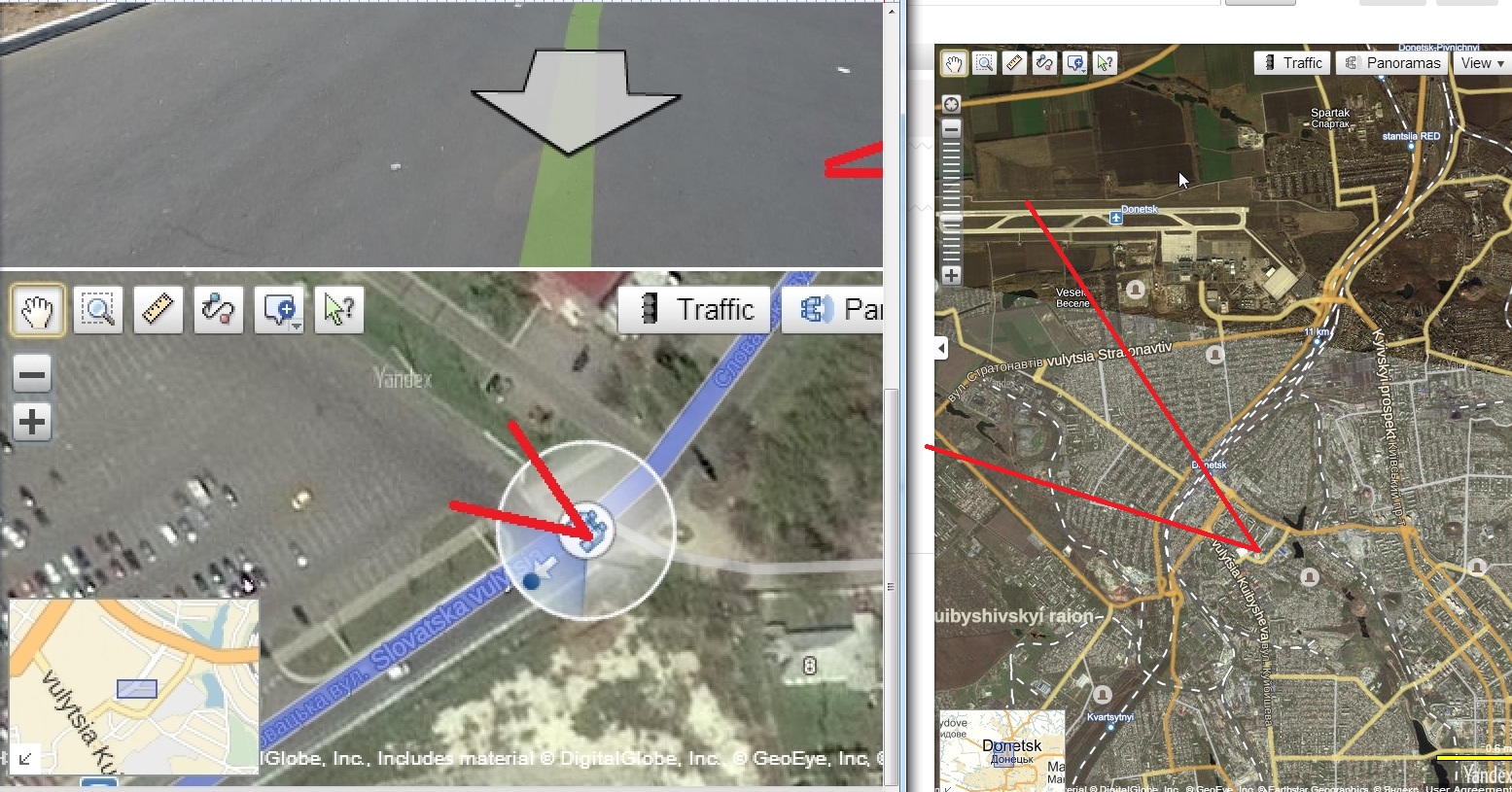
In the pictures above you can see the store which was hit in the background, but we’ve also noted the impact of a third rocket which hit the apartment building from which the first video was taken. Here are the Kuibyshev Street high-rise apartments from Google Street View. The video clearly shows that the building to the left was hit by a shell just to the right (to the north) of the outcrop of apartment balconies:
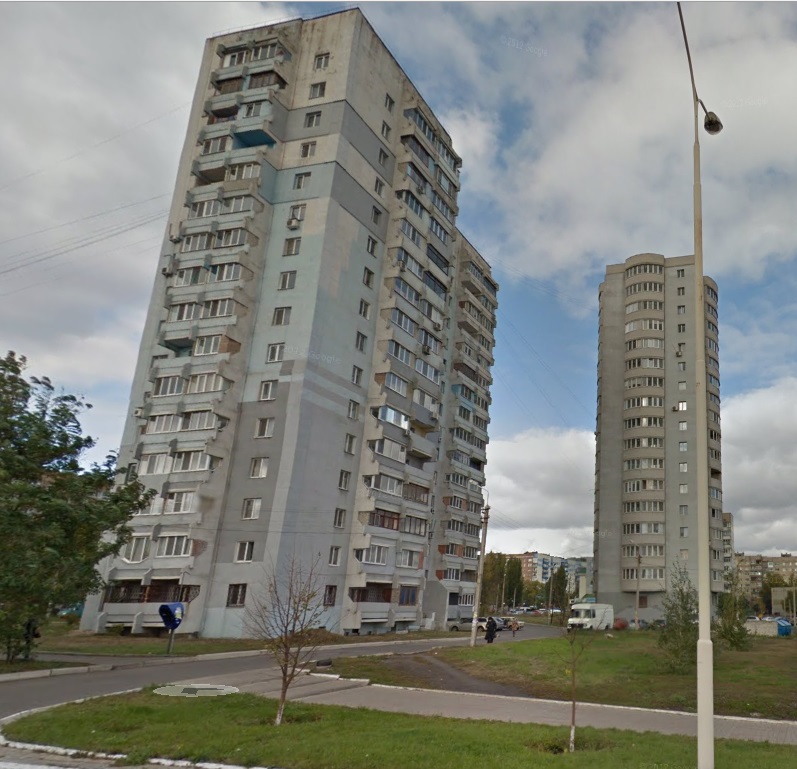
Here is the damage:
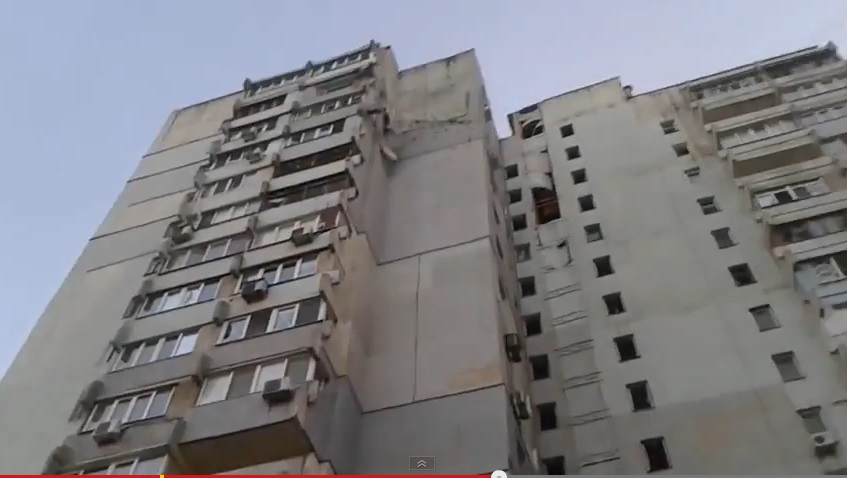
Here is an important breakdown of what we are looking at. The shell which hit the building hit a corner which is facing northeast. It could not have come from the southwest, west, or northwest, or it would have hit a different side of this building. It could not have come from due-north as the nearby apartment building would have taken the hit (marked by a square). We have drawn arrows which point to the Donetsk Airport, partially occupied by the Ukrainian military, and as you can see it is likely not possible for rockets fired from that position to hit this building.
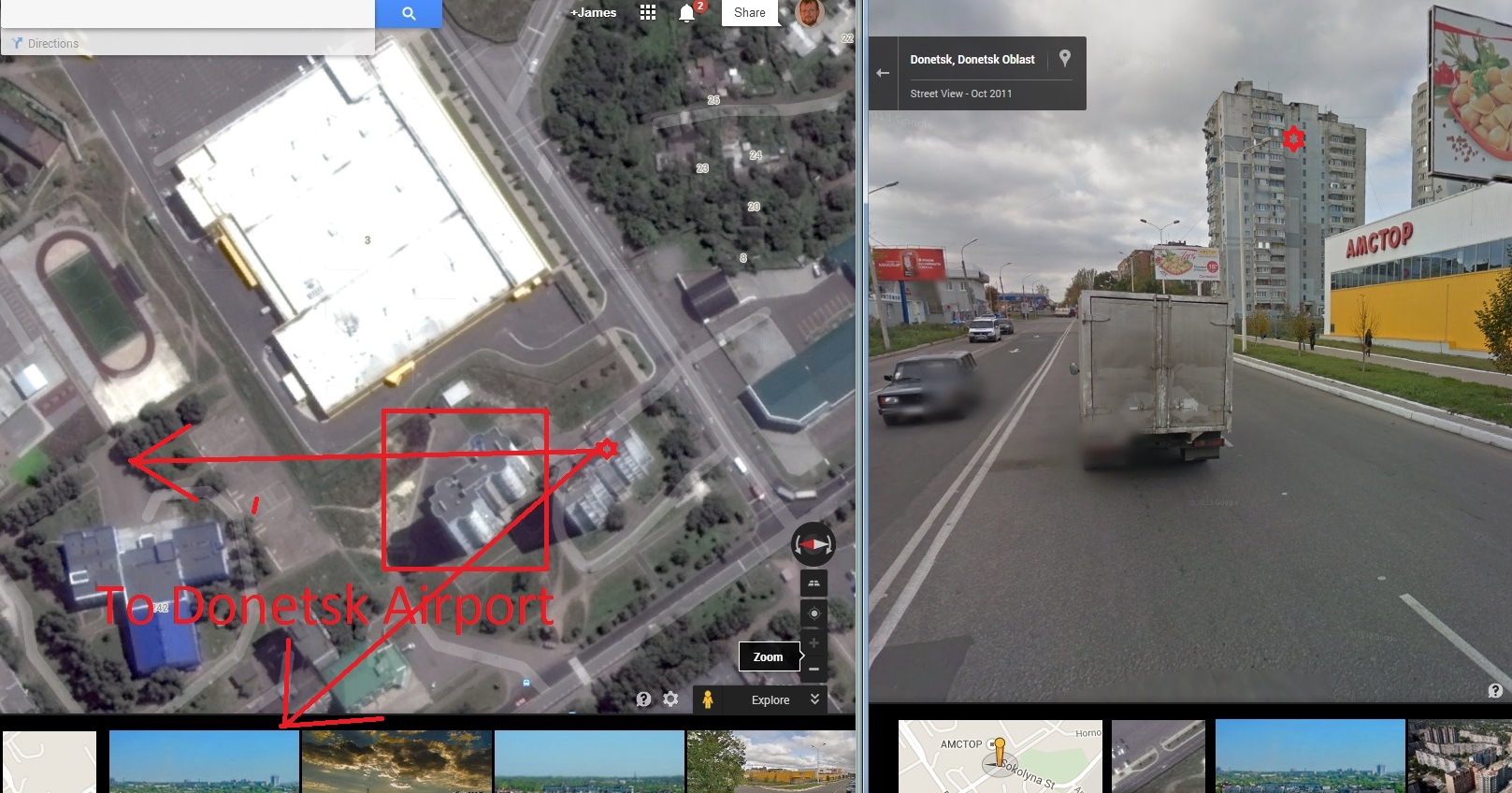
The rocket could have come from the east, east-northeast, or southeast in which case the rocket would have just clipped the part of the building which juts out.
So based on all of this information we have placed all three impact zones, with our best guess as to the trajectory of the incoming fire. As you can see, based on this analysis, the area may have been hit from shells fired from multiple positions:
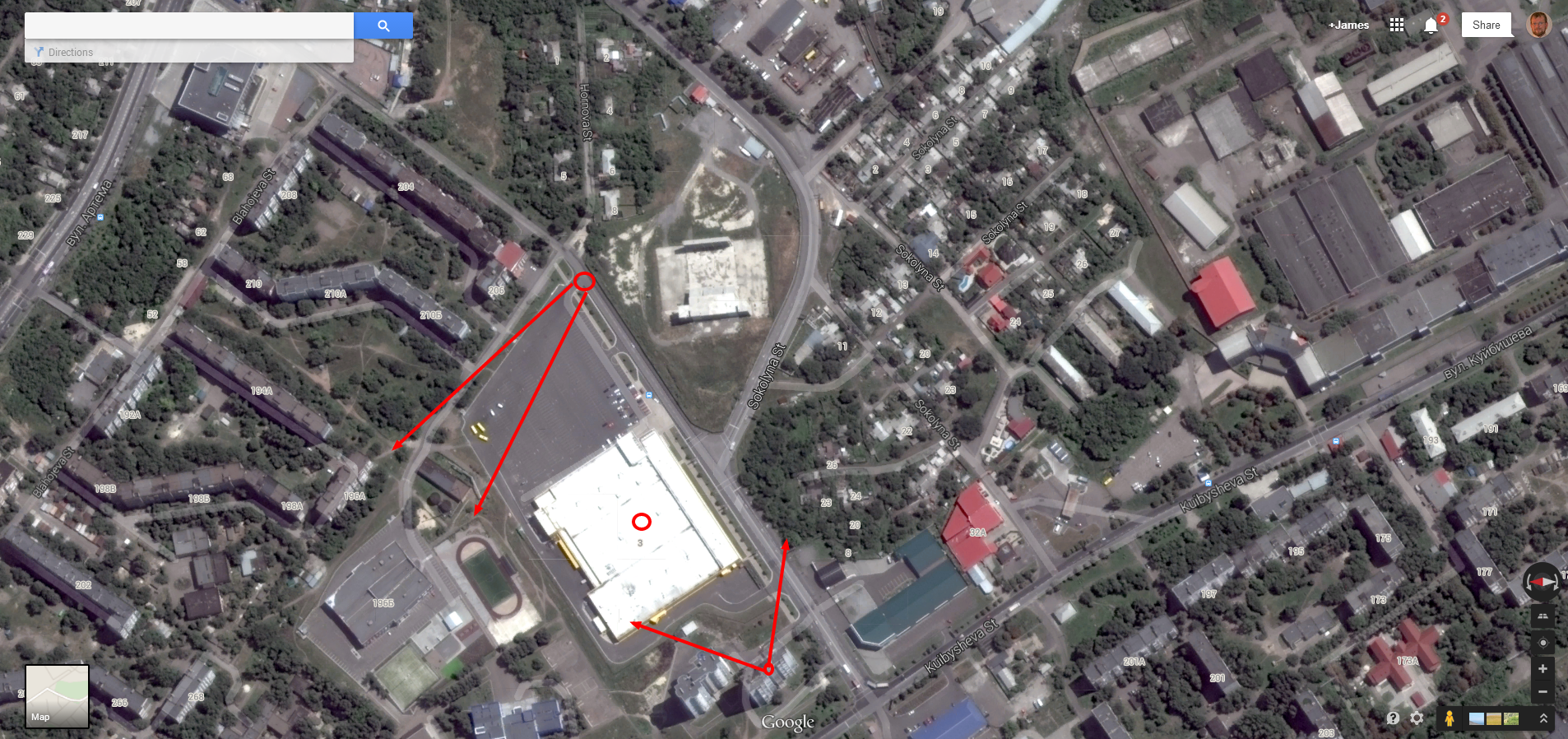
We showed some of these findings to the blogger @djp3tros from Ukraine@War and he confirmed our theory that the shell which hit the apartment came somewhere from the east, from the opposite direction of Ukraine’s forces either west of Donetsk or north of here at the airport. In particular he focused on the damage to the apartment:
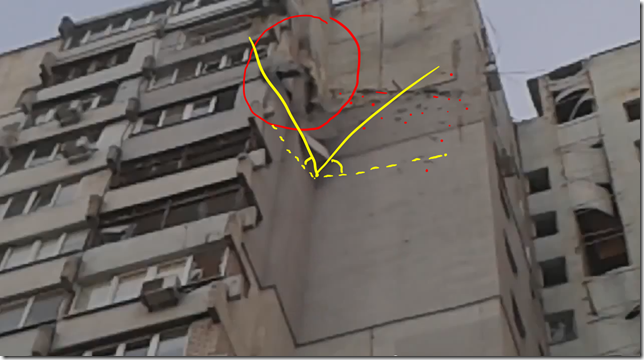
Placing that cone of fire on a Google map shows that a known separatist gun position is within this cone of fire, to the east-northeast of this apartment and east of the Donetsk airport. Previous investigations have shown that this gun position is responsible for firing on Donetsk airport.
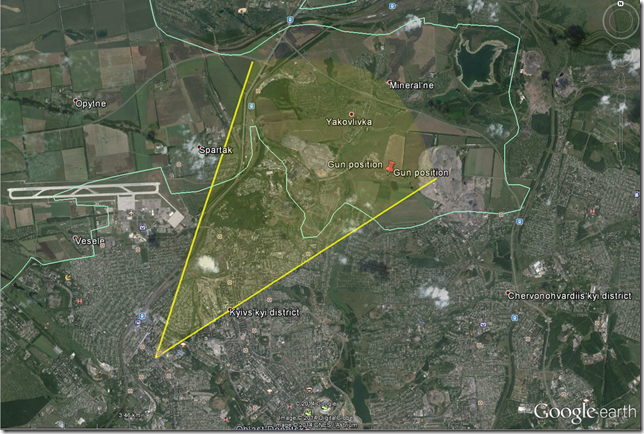
The Russian-backed separatists have plenty of weapons with which they’re shelling Donetsk airport. They have known artillery positions to the northeast, east, southeast, and south of Donetsk, any number of which could hit this position with one of the separatists’ favorite weapons — Grad rockets.
We also know that the Ukrainian troops trapped in the airport are returning fire, and some of that fire has hit civilian-held areas. At the end of the day, however, they are the ones who are under siege, and the separatists are firing at the airport from residential areas. Until a solution for the fighting at Donetsk airport is negotiated, or until the base falls to the Russian-backed separatists, or until the Ukrainian military regains control of Donetsk, civilians are likely to remain collateral damage in the fighting.
We will continue to analyze this evidence to see if we can more-definitively determine from where this fire is coming.
One of the passengers who was killed when Malaysian Airlines flight MH17 was shot out of the sky on July 17th may not have died instantly. Dutch prosecutors say that the body of the passenger was found with the elastic band of an oxygen mask wrapped around his neck. Bloomberg reports:
Oxygen masks are immediately released on passengers when cabins lose pressure, as would happen if a fuselage were punctured. Investigators of the crash, which killed all 298 people on board, have said the plane was brought down by an external impact, possibly a missile, as it traversed a war zone in eastern Ukraine en route to Malaysia from the Netherlands…
Even if one passenger had time to pull the mask over his face, it remains unclear how long passengers on the plane remained conscious following the loss of cabin pressure.
“This suggests the aircraft cabin pressure monitoring systems continued to operate, masks dropped, and at least one passenger had time to react to mask availability and don a mask,” said Robert Mann, president of R.W. Mann & Co, adding it remains plausible that a detached mask became tangled around the passenger’s neck in the destruction that followed.
For the latest summary of all of the evidence regarding the question of who is responsible for the downing of flight MH17, read our UPDATED Evidence Review: Who Shot Down Malaysian Airlines Flight MH17?
The lustration law, a law designed to root corruption out of the government and remove politicians who are more loyal to Russia and/or the former administration than the current one, has now been signed into law by President Poroshenko. RFE/RL reports:
Under the law, up to one million public servants, including cabinet ministers will be screened for loyalty to root out the corrupt practices of previous pro-Russian President Viktor Yanukovych’s administration.
The law is expected to purge officials linked to the pro-Russian separatists in Ukraine’s east and other Russian structures.
Officials unable to explain their sources of income and assets will be banned from public office for five to 10 years.
Poroshenko said he signed the bill with the aim of “restoring confidence in [Ukraine’s] authorities.”
Ukrainian officials whom The Interpreter has spoken to have all stressed the need for the lustration law for several key reasons. The first is that corruption has sapped so much of Ukraine’s budget. When this new government came to power riding a wave of anti-corruption protests, even the opposition politicians were surprised to find that the state coffers were emptier than they had anticipated and the military had been decimated by years of corruption and inaction. Many of those problems have continued since the new administration took control because the culture of corruption is so deeply embedded into the government and since many of the corrupt practices are actually written into the law.
So the first reason why lustration is important is because eliminating state income lost to corruption frees up money for other things — like funding the military which is effectively at war to defend eastern Ukraine against a Russian invasion.
But the second reason lustration is important, according to Ukrainian officials, is that reforms have been blocked, slowed, or subverted by corrupt officials who have close ties to ousted President Viktor Yanukovych and/or the Russian government. Even inside the military and the defense ministry there are concerns that Russian spies are relaying information back to Moscow.
Ultimately, not only was the lustration law identified as a priority by officials we’ve spoken to, but so too are the upcoming parliamentary elections.
Russia has passed a new law which will compensate those who are targeted by Western sanctions related to Russia’s actions in Ukraine. The Wall Street Journal reports:
Russia’s parliament gave preliminary approval on Wednesday to a draft law that would allow state compensation to citizens and companies affected by Western sanctions over Ukraine.
The legislation would also allow the seizure of property in Russia owned by foreign entities who instigate cases against Russians abroad.
The move, however, met with disapproval from Economy Minister Alexei Ulyukayev, who warned it would increase already-large capital outflows.
In an unusually controversial parliamentary division, 233 lawmakers from the ruling United Russia party voted in favor, while 202 from other Kremlin-friendly parties opposed the bill.
The legislation is unofficially called the “Rotenberg Law” after Putin ally Arkady Rotenberg who had $40 million in real estate seized by Italian leadership.
But the law has a darker and less obvious side. The people who have been targeted by Western sanctions have mostly been wealthy oligarchs, business owners, and allies of Putin. These are people who were wealthy before Russian intervention in Syria, and all of them became more wealthy as a result of Putin’s policies over the years. They will likely be the only beneficiaries of this new law. International Business Times reports:
“Why should we compensate people with yachts on the Côte d’Azur when we can’t support unborn children?” Alexei Didenko, a Liberal Democratic Party lawmaker from Crimea, was quoted as saying in a Bloomberg report. He was referring to a debate among Russian lawmakers whether to discontinue a program that provides cash payments to mothers.
Russia’s Economy Minister Alexei Ulyukayev was also critical of the legislation, warning that it could cause further capital outflow, according to Reuters.
“Basically, we encourage the outflow of capital from the country in different forms, that is not the objective of our economic policy,” Ulyukayev, who spoke in the Duma before the bill’s reading, said. “From my point of view [the law] would be counterproductive.” The Moscow Times reports that Russian Finance Ministry estimates show that Russia’s capital outflow will hit $120 billion, or 6 percent of GDP, this year.
It’s no wonder, then, that the majority of Ukrainians believe that they are at war with Russia. Kyiv Post reports:
Over seventy percent of Ukrainians said that there is a war between Russia and Ukraine, according to a poll conducted by Kyiv International Institute of Sociology (KIIS) in cooperation with Ilko Kucheriv Democratic Initiatives Foundation.
What’s even more concerning, however, is that the Ukrainian people are increasingly interested in becoming a nuclear state once again. Ukraine, it should be remembered, once had nuclear weapons. In 1991, after more than 90% of Ukrainians voted to become independent from the USSR (another fact often forgotten), Ukraine became a significant nuclear power. However in 1994, under the internationally-brokered Budapest Memorandum, Ukraine gave up their nuclear weapons in exchange for security guarantees from Russia.
Now, a growing number of Ukrainians want their nukes back.
A new poll conducted by the Razumkova Center shows that 46.2% of Ukrainians believe that the new Ukrainian government is not capable of ensuring Ukraine’s sovereignty, independence and territorial integrity, Ukrainska Pravda and Interfax Ukraine reported (translated by The Interpreter).
Only 10.7% of those surveyed believe that the government’s current security and defense policies are sufficient to meet national interests.
At the same time 42% of respondents believe that the government does meet national security interests in part, and 30.9% believe it does not; 16.4% were undecided.
A total of 49.3% of respondents believe that Ukraine must once again acquire the status of a nuclear power; 27.7% are opposed.
Moreover, the majority of residents in the western (64.3%) and central (60.3%) regions of Ukraine support the nuclear status and a relative majority of residents in the south of the country (39.5%).
In the eastern region, the number of supporters (36.8%) and opponents (39.5%) of a nuclear status for Ukraine is about the same.
The survey of 2,014 people throughout all the regions of Ukraine was conducted from September 5-10. The sampling error does not exceed 2.3% with a probability of 0.95%.
The fact that Ukrainians want their nuclear weapons back is a serious blow to global nuclear proliferation efforts. How can the international community ask small countries to stop pursuing nuclear weapons when Ukraine did just that and has now been invaded by Russia?
While on the topic of war and enemies, and interesting poll came out today that says Russians now believe that America is their number one enemy: